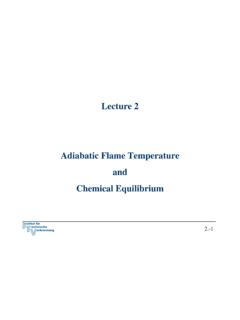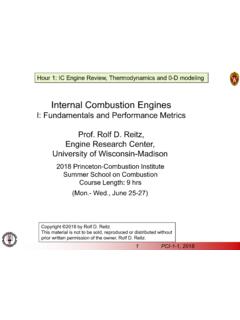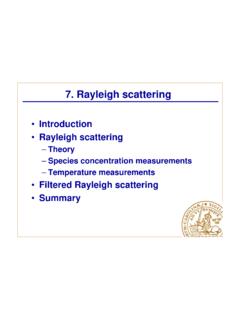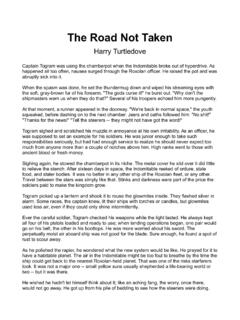Transcription of Laminar Premixed Flames: Kinematics and Burning Velocity
1 Laminar Premixed Flames: Kinematics and Burning Velocity CEFRC Combustion Summer School Prof. Heinz Pitsch 2014 Copyright 2014 by Heinz Pitsch. This material is not to be sold, reproduced or distributed without prior written permission of the owner, Heinz Pitsch. Course Overview 2 Introduction Fundamentals and mass balances of combustion systems Thermodynamics, flame temperature, and equilibrium Governing equations Laminar Premixed flames: Kinematics and Burning Velocity Laminar Premixed flames: Flame structure Laminar diffusion flames Introduction Kinematic balance for steady oblique flames Laminar Burning Velocity Field equation for the flame position Flame stretch and curvature Thermal-diffusive flame instability Hydrodynamic flame instability Part I: Fundamentals and Laminar Flames Premixed combustion used in combustion devices when high heat release rates are desired Small devices Low residence times Examples.
2 SI engine Stationary gas turbines Advantage Lean combustion possible Smoke-free combustion Low NOx Disadvantage: Danger of Explosions Combustion instabilities Large-scale industrial furnaces and aircraft engines are typically non- Premixed Laminar Premixed Flames 3 Premixed Flames 4 Premixed flame: Blue or blue-green by chemiluminescence of excited radicals, such as C2o and CHo Diffusion flames: Yellow due to soot radiation Turbulent Premixed Flame (Dunn et al.) Laminar Bunsen Flame Flame Structure of Premixed Laminar Flames 5 Fuel and oxidizer are convected from upstream with the Burning Velocity sL Fuel and air diffuse into the reaction zone Mixture heated up by heat conduction from the burnt gases Fuel consumption, radical production, and oxidation when inner layer temperature is reached Increase temperature and gradients Fuel is entirely depleted Remaining oxygen is convected downstream Cut through flame Course Overview 6 Introduction Fundamentals and mass balances of combustion systems Thermodynamics, flame temperature, and equilibrium Governing equations Laminar Premixed flames: Kinematics and Burning Velocity Laminar Premixed flames.
3 Flame structure Laminar diffusion flames Introduction Kinematic balance for steady oblique flames Laminar Burning Velocity Field equation for the flame position Flame stretch and curvature Thermal-diffusive flame instability Hydrodynamic flame instability Part I: Fundamentals and Laminar Flames Premixed Flame in a Bunsen Burner 7 Fuel enters the Bunsen tube with high momentum through a small orifice High momentum underpressure air entrainment into Bunsen tube Premixing of fuel and air in the Bunsen tube At tube exit: homogeneous, Premixed fuel/air mixture, which can and should(!) be ignited Kinematic Balance for Steady Oblique Flame 8 In steady state, flame forms Bunsen cone Velocity component normal to flame front is locally equal to the propagation Velocity of the flame front Burning Velocity Kinematic Balance for Steady Oblique Flame 9 Laminar Burning Velocity sL,u.
4 Velocity of the flame normal to the flame front and relative to the unburnt mixture (index u ) Can principally be experimentally determined with the Bunsen burner Need to measure - Velocity of mixture at Bunsen tube exit -Bunsen cone angle Kinematic Balance for Steady Oblique Flame 10 Splitting of the tube exit Velocity in components normal and tangential to the flame Kinematic balance yields relation unburnt gas Velocity and flame propagation Velocity For Laminar flows: Kinematic Balance for Steady Oblique Flame 11 Flame front: Large temperature increase Pressure almost constant Density decreases drastically Mass balance normal to the flame front: Normal Velocity component increases through flame front Momentum balance in tangential direction: Deflection of the streamlines away from the flame Laminar Bunsen flame (Mungal et al.)
5 Burning Velocity at the Flame Tip 12 Tip of the Bunsen cone -Symmetry line - Burning Velocity equal to Velocity in unburnt mixture -Here: Burning Velocity = normal component, tangential component = 0 Burning Velocity at the tip by a factor 1/sin( ) larger than Burning Velocity through oblique part of the cone Laminar Bunsen flame (Mungal et al.) Burning Velocity at the flame tip 13 Explanation: Strong curvature of the flame front at the tip Increased preheating -In addition to heat conduction normal to the flame front preheating by the lateral parts of the flame front Effect of non-unity Lewis numbers Explanation of difference between lean hydrogen and lean hydrocarbon flames Laminar Bunsen flame (Mungal et al.)
6 Course Overview 14 Introduction Fundamentals and mass balances of combustion systems Thermodynamics, flame temperature, and equilibrium Governing equations Laminar Premixed flames: Kinematics and Burning Velocity Laminar Premixed flames: Flame structure Laminar diffusion flames Introduction Kinematic balance for steady oblique flames Laminar Burning Velocity Field equation for the flame position Flame stretch and curvature Thermal-diffusive flame instability Hydrodynamic flame instability Part I: Fundamentals and Laminar Flames Measuring the Laminar Burning Velocity 15 Spherical constant volume combustion vessel -Flame initiated by a central spark -Spherical propagation of a flame -Measurements of radial flame propagation Velocity drf /dt Kinematic relation for flame displacement speed Flame front position and displacement speed are unsteady Pressure increase negligible as long as volume of burnt mixture small relative to total volume Influence of curvature Measuring the Laminar Burning Velocity 16 Flame front Velocity in a spherical combustion vessel 17 Velocity relative to flame front is the Burning Velocity Different in burnt and unburnt region From kinematic relation Velocity on
7 The unburnt side (relative to the flame front) Burnt side of the front Spherical propagation: Due to symmetry, flow Velocity in the burnt gas is zero Mass balance yields: drf /dt vu Flame front Velocity in a spherical combustion vessel 18 From mass balance and kinematic relation follows Flow Velocity on the unburnt side of the front Flow of the unburnt mixture induced by the expansion of the gases behind the flame front Measurements of the flame front Velocity drf /dt Burning Velocity sL,u: Relation between sL,u and sL,b 19 Burning Velocity sL,u defined with respect to the unburnt mixture Another Burning Velocity sL,b can be defined with respect to the burnt mixture Continuity yields the relation.
8 In the following, we will usually consider the Burning Velocity with respect to the unburnt sL = sL,u Flat Flame Burner and Flame Structure One-dimensional flame Stabilization by heat losses to burner In theory, Velocity could be increased until heat losses vanish, then unstretched uu = sL Analysis of flame structure of flat flames -Measurements of temperature and species concentration profiles 20 The general case with multi-step chemical kinetics 21 Laminar Burning Velocity sL can be calculated by solving governing conservation equations for the overall mass, species, and temperature (low Mach limit) Continuity Species Energy The general case with multi-step chemical kinetics 22 Continuity equation may be integrated once to yield Burning Velocity is eigenvalue, which must be determined as part of the solution System of equations may be solved numerically with -Appropriate upstream boundary conditions -Zero gradient boundary conditions downstream The general case with multi-step chemical kinetics 23 Example: Calculations of the Burning Velocity of Premixed methane-air flames Mechanism that contains only C1-hydrocarbons sL underpredicted Including C2-mechanism [Mauss 1993] Better agreement The general case with multi-step chemical kinetics 24 Example.
9 Burning velocities of propane flames taken from Kennel (1993) sL typically decreases with increasing pressure but increases with increasing preheat temperature Burning Velocity 25 Burning Velocity is fundamental property of a Premixed flame Can be used to determine flame dynamics Depends on thermo-chemical parameters of the Premixed gas ahead of flame only But: For Bunsen flame, the condition of a constant Burning Velocity is violated at the tip of the flame Curvature must be taken into account Next We will first calculate flame shapes Then we will consider external influences that locally change the Burning Velocity and discuss the response of the flame to these disturbances Course Overview 26 Introduction Fundamentals and mass balances of combustion systems Thermodynamics, flame temperature, and equilibrium Governing equations Laminar Premixed flames: Kinematics and Burning Velocity Laminar Premixed flames.
10 Flame structure Laminar diffusion flames Introduction Kinematic balance for steady oblique flames Laminar Burning Velocity Field equation for the flame position Flame stretch and curvature Thermal-diffusive flame instability Hydrodynamic flame instability Part I: Fundamentals and Laminar Flames A Field Equation Describing the Flame Position 27 Kinematic relation between Displacement Velocity Flow Velocity Burning Velocity May be generalized by introducing vector n normal to the flame where xf is the vector describing the flame position, dxf/dt the flame propagation Velocity , and v the Velocity vector A Field Equation Describing the Flame Position 28 Normal vector points towards the unburnt mixture and is given by where G(x,t) can be identified as a scalar field whose level surface represents the flame surface and G0 is arbitrary The flame contour G(x,t)




![Lecture 8 Raman [Kompatibilitetsläge]](/cache/preview/d/b/6/8/9/c/e/c/thumb-db689cecbc617a8952df49950b757eeb.jpg)








